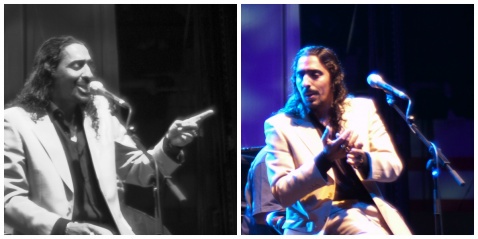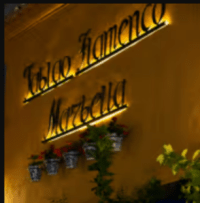
Diego Jiménez Salazar- El Cigala © andalucia.com |
|
The Early Years
Diego Jiménez Salazar was born in Madrid in 1968 and today he has become one of the top cantaores (singers of flamenco) in Spain. He was given the name of El Cigala by another legend from the flamenco world, Camaron de la Isla, a man that El Cigala had much respect and admiration for.
Without scripts or structured compositions, the Flamenco artists let themselves be carried away by improvisation and the passion of flamenco. Witness dancing and singing, where the a cappella voice, the guitar chords and the rhythm of the dancers will fill the stage. Dining optional. Tickets for Flamenco Show at Tablao Flamenco in Marbella.
Diego el Cigala grew up in the El Rastro district of Madrid and it was in the local market that he performed as a child. He was brought up in the midst of a flamenco environment; Madrid was once the center of flamenco, especially during the 1970s.
He is also the nephew of Rafael Farina, another legend of Spanish music and film. El Cigala’s first encounter with recognition was at the age of twelve when he won a local flamenco competition, and in the same year he was awarded the Gente Joven prize in a television contest.
He started to accompany the dance with his raucous gypsy voice and soon became in great demand by dancers such as El Farruco, Manolete, and Mario Maya. His voice was also used in the studio recordings of some of flamenco’s greatest guitarists including Tomatito and Vicente Amigo and later in his career he was to sing on the Cd Cositas Buenas, by the guitar maestro Paco de Lucía.
But like many flamenco artistes, he was only known in the flamenco world and it was to be many years before he would reach the heights of an international artiste.
The Recordings
He has made numerous Cds including Undebel, which was his first solo recording in 1994, followed by Entre vareta y canasta in 2000 and he also collaborated in the collective tribute to Juan Valdarrama, Madre Hermosa along withCarmen Linares and Pepe Habichuela.
Other recordings include Corren tiempos de alegria, 2001, and a live recording Directo en el Teatro Real the following year, but it was to be his next project that was to catapult him to international stardom.
Like most good flamenco singers, Cigala’s fame was somewhat limited to Spain, and with the exception of the hardened flamenco aficionados that are scattered around Europe and America, that is more or less where it stayed.
Bebo & Cigala
In 2003, El Cigala entered a Madrid recording studio with the legendary Cuban pianist Bebo Valdes, and after a few months presented an album of songs that were a fusion of El Cigala’s coarse gypsy voice along with the expert piano work of Bebo Valdes and a collection of other respected Cuban musicians.
Diego el Cigala is a flamenco singer who knows well the orthodox styles of flamenco and he has spent the first twenty years of his career performing these traditional songs. But the Cd Lagrimas Negras, was to invent him as a serious musician capable of entering the international scene. His “fresh flamenco” style melded with the laid back Cuban jazz feel of Bebo Valdes was to create a new avenue for him to explore.
Lagrimas Negras reached double platinum sales figures and was awarded five Spanish and two Latin Grammy awards.
He toured extensively with Valdes to promote the Cd, giving sell out performances to audiences’ world wide and receiving rave revues and acknowledgements from the music world.
Valdes and Cigala also released a dvd, Blanco y Negro, which captures one of the live performances in Mallorca, Spain, as well as a behind-the-scenes look at the recording of the Cd that also includes interviews with the musicans
El Cigala is not the first respected flamenco artiste to branch out in a different direction with his music, he is also not the first to be highly criticized for it. Many “dyed in the wool” critics deem it a dishonor for an artist to leave the confines of his flamenco boundaries and fuse flamenco with other styles of music. Some also believe that once you have strayed from these confines you can never go back to perform orthodox jondo flamenco; accusations that Paco de Lucía and José Mercé have proven to be unfounded on many occasions.
His next recording returned to the more traditional style flamenco for which he is renown, Picasso en mis ojos, which was a tribute to the great painter from Málaga.
The album contained tangos, bulerias, fandangos and alegrias, but this record did not receive the acclaim of Lagrimas Negras, even with the excellent guitar work of Tomatito and Paco de Lucía, who assisted El Cigala on the Cd.
Even the release of his Dos Lagrimas, the second part of the Cuban jazz influence has yet failed to match the brilliance of the first.
Bebo passed away in 2013
Diego el Cigala is one of today’s top Spanish artistes
One thing that is for certain is that Diego el Cigala is one of today’s top Spanish artistes, and even though he still performs at the summer festivals, today his flamenco is more commercial than the cante jondo that he first began with in the streets of Madrid.
His live performances have a relaxed laid back feel to them, rather like that of a jazz quartet, and with musicians like the Cuban pianist, Guillermo Rubalcaba, on Piano and Manuel Machado on trumpet, its no wonder.
His most recent albums are
2010 - Cigala & Tango
2013 - Romance de la luna Tucuman
He has toured in many countries many countries with sold out gigs in Mexico, Australia and New Zealand
To date in 2016, El Cigala has recorded eight CDs and has won two Grammys plus a total of 5 Latin Grammy nominations.
Recommended viewing and listening.
Cd. Directo en el Teatro Real. / Lagrimas Negras
Dvd. Blanco y Negro, Bebo y Cigala live.
